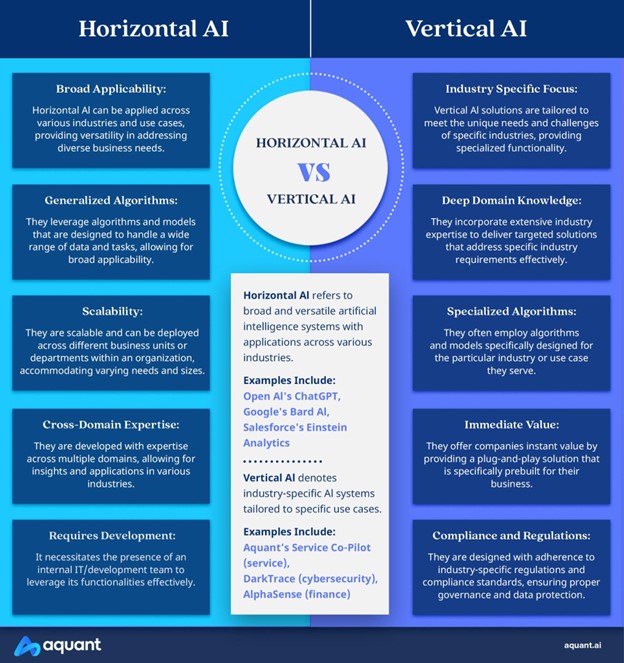
While horizontal AI solutions still hold value in providing more generalized capabilities, vertical AI solutions are expected to provide more value in the future.
As the AI landscape expands, two distinct categories are emerging: horizontal and vertical AI solutions. Horizontal AI encompasses ubiquitous and generalized applications, such as ChatGPT or Google Bard, while vertical AI focuses on specialized and tailored tools for specific industries, like Service Co-Pilot, Harvey, or Jasper. In this article, we will explore the key differences between these two categories, examine their respective benefits and challenges, and shed light on real-world examples that demonstrate how horizontal and vertical AI solutions are revolutionizing businesses across various sectors.
Understanding the Differences between Horizontal and Vertical AI Solutions
Horizontal AI solutions are designed to be versatile and widely applicable, serving as a foundation for various industries. These solutions possess a broad scope and can be integrated into different domains, including customer service, content generation, and general information retrieval. Examples like ChatGPT and Google Bard demonstrate the potential of horizontal AI to generate human-like responses, engage in natural language conversations, and provide valuable insights. Their versatility makes them readily available for businesses seeking AI solutions that can be quickly adapted to their specific needs.
In contrast to horizontal AI, vertical AI solutions are tailored to specific industries, addressing their unique requirements and challenges. By leveraging domain-specific knowledge and expertise, vertical AI solutions offer advanced functionalities and specialized capabilities. These solutions provide industry-specific insights, optimize processes, and enhance decision-making, thereby revolutionizing operations within sectors like service, legal, marketing, and beyond. For instance, Service Co-Pilot streamlines service management, Harvey assists in legal research and analysis, and Jasper optimizes marketing strategies, showcasing how vertical AI solutions can unlock new levels of efficiency and productivity in specific domains.
See also: AI Revolution to Hit Law, Medicine, Finance Hardest
Benefits and Challenges of Horizontal and Vertical AI Solutions

Benefits of Horizontal AI Solutions:
- Versatility: Horizontal AI solutions offer a wide range of applications, providing flexibility across industries and enabling businesses to address multiple use cases with a single tool.
- Accessibility: These solutions are often readily available and user-friendly, requiring minimal customization or integration efforts.
- Cost-efficiency: With their generalized nature, horizontal AI solutions can be a cost-effective choice for businesses looking to implement AI capabilities without extensive investments in specialized development.
Challenges of Horizontal AI Solutions:
- Lack of specialization: Horizontal AI solutions may not offer the same depth of domain-specific knowledge and expertise as their vertical counterparts, limiting their ability to deliver accurate and personalized insights and optimizations.
- Generic outputs: Due to their generalized nature, horizontal AI solutions may produce outputs that lack the nuance and specificity required for certain industry applications.
- Competition: As horizontal AI solutions become more commonplace, businesses might find it challenging to differentiate themselves using off-the-shelf solutions.
Benefits of Vertical AI Solutions:
- Domain expertise: Vertical AI solutions leverage specialized knowledge and expertise, enabling businesses to gain insights and make informed decisions specific to their industry.
- Tailored functionality: These solutions are designed to address industry-specific challenges, providing functionalities and features that align with the unique requirements of the sector.
- Enhanced efficiency and productivity: Vertical AI solutions streamline processes, automate tasks, and optimize workflows, empowering businesses to operate more efficiently and achieve higher levels of productivity.
Challenges of Vertical AI Solutions:
- Development complexity: Creating vertical AI solutions requires an in-depth understanding of the industry’s intricacies, resulting in potentially complex development processes.
- Integration hurdles: Integrating vertical AI solutions into existing infrastructure and workflows may pose challenges, particularly if compatibility issues arise.
- Limited scalability: Because they are built for specific industries and use cases, vertical AI solutions may have a narrower target audience compared to horizontal AI solutions.
While horizontal AI solutions still hold value in providing more generalized capabilities, Vertical AI solutions are expected to provide more value in the future as organizations begin to rely more heavily on generative AI due to several reasons. Firstly, vertical AI solutions leverage specialized industry knowledge and domain expertise, allowing them to deliver more accurate and relevant insights compared to general-purpose solutions. This specialized focus enables them to optimize their algorithms and data processing techniques, resulting in enhanced performance, efficiency, and faster time to value for businesses.
Additionally, vertical AI solutions are designed with industry-specific regulations and compliance in mind, reducing the risk and complexity associated with adopting AI technologies in highly regulated sectors. They also provide deeper insights and decision-making support by offering contextual and industry-specific recommendations, predictions, and optimizations. Ultimately, these solutions provide businesses with a competitive advantage by addressing industry-specific challenges and optimizing operations to meet their unique goals and requirements.



























